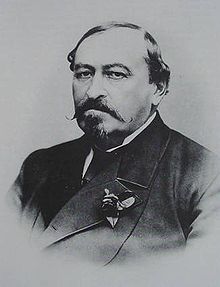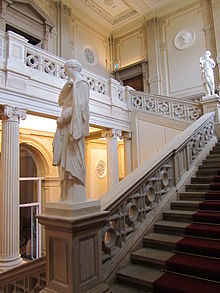This is an old revision of this page, as edited by AnomieBOT (talk | contribs) at 10:55, 18 December 2024 (Substing templates: {{Coordinate}} and {{Normdaten}}. See User:AnomieBOT/docs/TemplateSubster for info.). The present address (URL) is a permanent link to this revision, which may differ significantly from the current revision.
Revision as of 10:55, 18 December 2024 by AnomieBOT (talk | contribs) (Substing templates: {{Coordinate}} and {{Normdaten}}. See User:AnomieBOT/docs/TemplateSubster for info.)(diff) ← Previous revision | Latest revision (diff) | Newer revision → (diff)
The Ducal Museum Gotha (German - Herzogliche Museum Gotha) is a museum in the German city of Gotha, located in the Schlosspark to the south of the Schloss Friedenstein. Its collection was the art collection of the former Duchy of Saxe-Gotha, consisting of Egyptian and Greco-Roman antiquities, Renaissance paintings such as The Gotha Couple, Chinese and Japanese art, and sculptures from various eras.
Reopening in 2013, it is housed in a 19th century Neorenaissance building owned by the city, whilst the museum itself is managed by the Friedenstein Castle Gotha Foundation, founded in 2004. Martin Eberle has been the Foundation's director since 2007.
History

19th century
20th century
21st century
List of directors
- Carl Aldenhoven (1879–1890)
- Karl Purgold (1890–1934)
- Eberhard Schenk zu Schweinsberg (1934–1946)
- Bruno Voigt (1946–1954)
- Michel Hebecker (1986–1992)
- Rudolf Funk (1992)
- Klaus Roewer (1995–1997)
- Elisabeth Dobritzsch und Ulrich Mahlau (1997–1998)
- Klaus Roewer (1998–1999)
- Rainer Samietz and Ulrich Mahlau (1999–2001)
- Katharina Bechler (2004–2006)
- Ulrich Mahlau (2006–2007)
- Martin Eberle (2007–2018)
- Tobias Pfeifer-Helke (2019-)
Displays
The basement displays show ancient Greek, Roman and Egyptian art and 18th century Italian cork models of buildings from those civilizations. Sculptures and temporary exhibitions are housed on the ground floor, whilst the first floor houses paintings (such as Dutch Renaissance works and ones by Lucas Cranach the Elder), Chinese porcelain, Japanese lacquerware and other East Asian art.
-
Fragment of a sarcophagus from Attica, 3rd century AD
-
The Gotha Couple, 1480
-
 Cranach the Elder, Christ and Mary Magdalene, 1516–20
Cranach the Elder, Christ and Mary Magdalene, 1516–20
-
 Cranach the Elder, Law and Grace, 1529
Cranach the Elder, Law and Grace, 1529
-
Gotha Altarpiece, 1540
-
 Caspar David Friedrich, Cross in the Mountains, 1823
Caspar David Friedrich, Cross in the Mountains, 1823
-
Bronze copy of the Farnese Bull, 1614
-
 Abraham de Vries, Portrait of an Unknown Man, 1643
Abraham de Vries, Portrait of an Unknown Man, 1643
-
Geniuses of Concord and Harmony, China, c. 1700
-
Yixing teapots, 18th century
-
Cork model of the Temple of Portunus, 18th century
-
Cork model of the Arch of Constantine, 18th century
Architecture


Bibliography
- (in German) Martin Eberle: Herzogliches Museum Gotha. Münzkabinett, Kupferstichkabinett, Ostasiatika. Mitteldeutscher Verlag, Halle (Saale) 2013, ISBN 978-3-95462-017-3.
- (in German) Stiftung Schloss Friedenstein Gotha (Hrsg.): Museen der Stiftung Schloss Friedenstein Gotha: Schlossmuseum, Museum der Natur, Museum für Regionalgeschichte und Volkskunde. Deutscher Kunstverlag, München/Berlin 2007, ISBN 978-3-422-06620-5.
- (in German) Wolfgang Zimmermann: Der Bau des Herzoglichen Museums zu Gotha (1864–1879). In: Harald Bachmann, Wener Korn, Helmut Claus, Elisabeth Dobritzsch (Hrsg.): Herzog Ernst II. von Sachsen-Coburg und Gotha, 1818–1893 und seine Zeit, Jubiläumsschrift im Auftrag der Städte Coburg und Goth. Maro Verlag, Augsburg 1993, ISBN 3-87512-198-8, S. 249–261.
External links
- (in German) Herzogliches Museums Gotha. In: StiftungFriedenstein.de
- (in German) Herzogliches Museums Gotha. In: Museen.Thueringen.de
- (in German) Herzogliches Museums Gotha. In: Museum.de
- (in German) Website des Freundeskreises Kunstsammlungen Schloss Friedenstein Gotha e. V.
References
- (in German) Homepage mitteldeutscher verlag
50°56′36″N 10°42′21″E / 50.94333°N 10.70583°E / 50.94333; 10.70583
Categories: